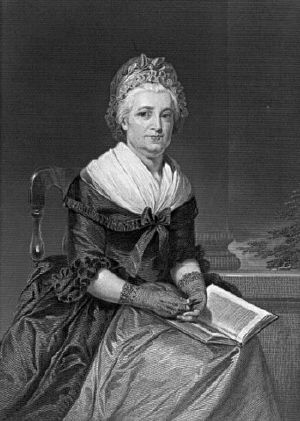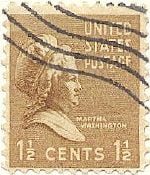Martha Dandridge Washington
Martha Dandridge Custis Washington (June 2, 1731 – May 22, 1802) was the wife of George Washington, the first president of the United States, and therefore is seen as the first First Lady of the United States (although that title was not coined until after her death; she was simply known as "Lady Washington").
Early Life
Martha ("Patsy") Dandridge was the eldest daughter of Virginia planter John Dandridge and Frances Jones. Martha was born near Williamsburg, Virginia. At the age of 18, she married Daniel Parke Custis, a rich bachelor two decades her senior. They had four children together. A son and a daughter, Daniel and Frances, died in childhood, but two older children, John (Jacky) Parke Custis and Martha ("Patsy") Parke Custis survived to young adulthood. Custis' death in 1757 left Martha a rich widow, with independent control over a dower inheritance for her lifetime and trustee control over the inheritance of her minor children.
Two years after the death of her first husband, Martha Dandridge Custis married Colonel George Washington on January 6, 1759. Shortly after the marriage, he left the colonial arm of the British military due to the British policy denying colonials command opportunities with the regular British army. They lived a prosperous and happy life at Washington's Mount Vernon estate. Martha and George Washington had no children together, but they raised Martha's two surviving children. John Parke Custis served as an aide to Washington during the siege of Yorktown in 1781. During this service, Jack died of typhus. After his death, the Washingtons raised two of his children, Martha's youngest grandchildren, Eleanor Parke Custis and George Washington Parke Custis. They also provided personal and financial support to nieces, nephews and other family members in both the Dandridge and Washington families.
First Lady
Content to live a private life at Mount Vernon and her homes from the Custis estate, Martha Washington nevertheless followed Washington into the battlefield when he served as Commander in Chief of the American Army. She spent the infamous winter at Valley Forge with the General, and was instrumental in maintaining some level of morale among officers and enlisted troops. She opposed his election as president of the newly formed United States of America, and refused to attend the inauguration, but gracefully fulfilled her duties as the official state hostess during their two terms.
Martha Washington and slavery
Martha Washington was raised in a time when chattel slavery was an economic reality for elite southern white families. She never questioned the ethical and moral foundations of the "southern institution." Under English common law, Martha received the use of and income from one third of Daniel Parke Custis' extensive estate during her lifetime. The estate contained a number of plantations and farms, and many enslaved men, women, and children attached to those holdings. Upon his marriage to Martha, George Washington became the legal manager of the Custis estate, under court oversight. In actuality, estate records indicate Martha Washington continued to make many decisions. Although the Washingtons wielded managerial control and received income from the estate, they could not sell Custis land or slaves, which were entailed to Martha's son, John ("Jacky") Custis.
Martha Washington was personally upset when her personal lady's maid Oney Judge, a slave girl of the Custis estate, fled the first family's Philadelphia household during President Washington's second term. Oney Judge hid with free black friends in the city, and then traveled to the north. Patricia Brady, in her 2005 biography of Martha Washington, writes:
- "Martha felt a responsibility for the unsophisticated girl under her care, especially since her mother and sister were expecting to see her back at Mount Vernon. What she could never understand was that (Oney had)...a simple desire to be free. Ona, as she preferred to call herself, wanted to live where she pleased, do what work she pleased, and learn to read and write....Ona Judge professed a great regard for Martha and the way she had been treated, but she couldn't face a future as a slave for herself and her children." (Brady, p. 209)
During the Washington family's last week in Philadelphia, their chief cook Hercules also fled slavery, leaving a daughter at Mount Vernon who told a visitor that she was glad her father was free.
Historian Henry Wiencek, in his award-winning 2004 book "An Imperfect God: George Washington, His Slaves, and the Creation of America", citing original documents he discovered in the files of Mount Vernon and the Virginia Historical Society, writes that Martha Washington owned her own mulatto half-sister, a slave named Ann Dandridge, who had a child by Martha's son (and therefore Ann's nephew), John Parke "Jack" Custis. According to Wiencek, this incident was among several that led George Washington to call slavery repugnant, and probably influenced Washington's decision late in life to free all his slaves. Another source on the existence of a slave named Ann Dandridge was Helen Bryan's 2001 "Martha Washington: First Lady of Liberty." In this book, which draws upon Wiencek's research, Bryan stated that the "shadow sister" was close to Martha's age and had been with her since they were children.
Wiencek writes that previous historians ignored the documentary evidence that this sister existed. In a brief bibliographical note at the end of her book(page 256), Patricia Brady denies the existence of Martha Washington's half sister and asserts that Wiencek and Bryan accepted "family mythology" and "lore." Brady does not offer a review of the documentary evidence discovered by Wiencek in the Virginia Historical Society and in the Washington, D.C., archives where Ann Dandridge's manumission is recorded—Land Records, Liber H., #8, p. 382; Liber R, #17, p. 288. In assessing the documents that have survived on this question, Wiencek notes that Ann Dandridge was omitted from the Custis estate records and the records of slaves at Mt. Vernon. Having studied plantation families for many years, Wiencek observes that family ties between slaves and slave owners were often kept hidden.
The Custis estate
Some of the estate left by Daniel Parke Custis to his descendants was eventually confiscated from George Washington Parke Custis's son-in-law, Robert E. Lee during the Civil War. The property later became Arlington National Cemetery. In 1882, after many years in the lower courts, the matter of the ownership of Arlington National Cemetery was brought before the United States Supreme Court. The Court affirmed a Circuit Court decision that the property in question rightfully belonged to the Lee family. The United States Congress then appropriated the sum of $150,000 for the purchase of the property from the Lee Family.
Later Life
Martha Washington survived her husband and died at Mount Vernon, Virginia. She was buried on May 22, 1802 at Mount Vernon. In 1831, her remains were moved from their original burial site a few hundred feet to a brick tomb that overlooks the Potomac River. In 1902 Martha Washington was the first American woman to be commemorated by a U.S. postal stamp.
Mrs. Washington had a row galley named in honor of her, the USS Lady Washington (1776). It holds the distinction of being the first U.S. military ship to be named in honor of a woman and for a vessel named while the person was still alive (see also List of U.S. military vessels named after living Americans. It has a number of other distinctions as well, as the first ship named after a first lady and the only known vessel in the Continental Navy named in honor of a woman.
ReferencesISBN links support NWE through referral fees
- Brady, Patricia. "Martha Washington: An American Life." Viking/Penquin Group, New York, New York, 2005. ISBN 0-670-03430-4.
- Wiencek, Henry. "An Imperfect God: George Washington, His Slaves, and the Creation of America." Farrar, Straus and Giroux, New York, hardbound edition 2003, paperback edition 2004. ISBN 0-374-52951-5.
External links
| Preceded by: None |
First Lady of the United States 1789–1797 |
Succeeded by: Abigail Adams |
((credit|77501957}}

